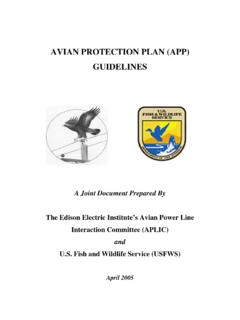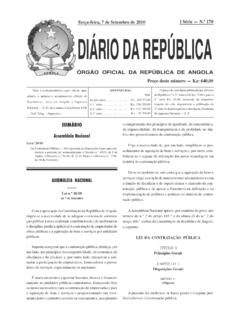Transcription of SAMPLE - APLIC
1 SAMPLER educing avian Collisions with power Lines The State of the Art in 2012 SAMPLETHIS PAGE INTENTIONALLY LEFT BLANKSAMPLER educing avian Collisions with power LinesThe State of the Art in 2012 Prepared by: avian power line Interaction CommitteeOctober 2012 SAMPLEA dditional copies of this book may be obtained through:the avian power line Interaction Committee ( ) and the Edison Electric Institute ( ).This book should be cited as follows: avian power line Interaction Committee ( APLIC ). 2012. Reducing avian Collisions with power Lines: The Stateof the Art in 2012.
2 Edison Electric Institute and APLIC . Washington, photos copyright (from left to right): Florida Fish and Wildlife Conservation Commission (transmission lines),Greg Forcey (great blue heron[Ardea herodias]),Jerry Liguori (American white pelican [Pelecanus erythrorhynchos]),Jerry Liguori (Canada geese [Branta canadensis]flying over power lines), and Laura C. Williams (whooping crane[Grus americana]).Section header photos copyright Jerry Liguori (Chapters 1 through 6), Fish and Wildlife Service (Chapter 7), Greg Forcey (Appendix A), Jerry Liguori (Appendices B, C, D, and E).
3 2012 by the Edison Electric Institute (EEI). All rights reserved. Published in the United States of America. No part of this publication may be reproduced or transmitted in any form or by any means, electronic ormechanical, including photocopying, recording, or any information storage or retrieval system or method,now known or hereinafter invented or adopted, without the express prior written permission of theEdison Electric by:Edison Electric Institute701 Pennsylvania Avenue, , 20004-2696 Phone: 202-508-5000 Website: Notice and DisclaimerThis work was prepared by the avian power line Interaction Committee ( APLIC ) for the Edison ElectricInstitute (EEI).
4 When used as a reference, attribution to APLIC is requested. APLIC , any member ofAPLIC, and any person acting on its behalf (a) does not make any warranty, express or implied, withrespect to the accuracy, completeness, or usefulness of the information, advice, or recommendationscontained in this work and (b) does not assume and expressly disclaims any liability with respect to theuse of or for damages resulting from the use of any information, advice, or recommendations contained in this views and opinions expressed in this work do not necessarily reflect those of APLIC , EEI, or anymember of APLIC or EEI.
5 This material and its production, reproduction, and distribution by EEI doesnot imply endorsement of the | iiicontentsAbstractxiForewordxvAcknowled gementsxviiDedication: Richard Dick S. Thorsell (1927 2012)xixChapter 1 Introduction1 Purpose and Scope of the Manual1 Reader Guide to the Manual3 Overview of power Lines4 Perspectives for Dealing with Bird Collisions10 Chapter 2 Progress in Dealing with Collision Issues13 North America13 International17 Future Research Priorities19 Chapter 3 avian Regulations and Compliance21 Overview of Existing Laws and Policies21 Permit Requirements26 Chapter 4 Understanding Bird Collisions29 Susceptibility of Birds to power line Collisions30 Identifying Collision Mortality30 Variability in Reported Mortality Rates31 Biological
6 Significance of Collision Mortality32 Biological Characteristics Influencing avian Collision Risks36 Environmental Conditions Influencing avian Collision Risks46 Engineering Aspects Influencing avian Collision Risks50 Chapter 5 Minimizing Collision Risks53 Opportunities for Minimizing Collision Risks53 Modifying Existing power Lines54 Planning New power Lines64 Public Participation to Address Social and Cultural Issues72 SAMPLEiv |ContentscontentsChapter 6 line Marking to Reduce Collisions75 Overview of line Marking Devices75 Effectiveness of Designs77 Marking Constraints and Considerations80 line Marking Devices85 Large Diameter Wire100 Chapter 7 avian Protection Plans103 Overview of avian Protection Plans103 Components of an avian Protection Plan104 Creating and Implementing an avian Protection Plan109 Appendix A: Literature Cited and Bibliography111 Appendix B: Designing Site-Specific Studies for Collision Monitoring137 Considerations for Site-Specific Collision Monitoring138 Issues Related to Estimating Mortality Rates143 Appendix C: Glossary147 Appendix D: Acronyms153 Appendix E.
7 Resources155 SAMPLEI llustrations| highest wire on a transmission line is the shield wire, which can be difficult for birds, especially flocking birds such as waterfowl, to of the electric power system from the generation facility to the customer (modified from Rural Utilities Service). lines (left) and distribution lines (right). comparison of transmission (typically to 58 m [60 to 190 ft] tall) (A) and distribution structures (typically to m [21 to 48 ft] tall) (B). (A) and vertical (B) transmission line phase conductors on a three-phase, single-circuit.
8 138-kV transmission underbuild on a double-circuit transmission wires are the highest wires on a transmission neutral wire is usually positioned below the phase conductors on a distribution high voltage direct current transmission line gather data to assess the risk of bird work with biologists to reduce risk through appropriate design and routing of power the public may help a utility meet requirements for electrical reliability and reduce collision risk to has helped fund studies on the effectiveness of different types of line marking devices in reducing bird collisions with power Canada, the first reported collision victims were snow have studied the effects of power line collisions on vulnerable species, such as the Ludwig s bustard of Europe, Asia, and of the susceptibility of some endangered species, such as the whooping crane, power lines in these species ranges require careful evaluation and , EPRI.
9 And CEC are three organizations that provide some funding for research on avian / power line Migratory Bird Treaty Act of 1918 is the legal cornerstone of bird protection in the United States, protecting more than 1,000 North American bird species such as this cedar waxwing (Bombycilla cedrorum).22 FIGUREPAGESAMPLEvi | Conservation Plans help landowners incorporate conservation measures for species, such as the wood stork (Mycteria americana), into their development geese (Branta canadensis) are protected by both the Migratory Bird Treaty Act and Canada s equivalent, the Migratory Birds Convention songbirds, such as these horned larks (Eremophilia alpestris)
10 ,are protected by the Migratory Bird Treaty eagles are protected under the Bald and Golden Eagle Protection Act and the Migratory Bird Treaty risk is highly variable among species, with heavy-bodied birds, such as this common loon (Gavia immer), being more vulnerable because they cannot readily of their higher reproductive rates, common bird species are generally at less risk of population effects from power line collisions. United States population of endangered whooping cranes has had such significant mortality from natural causes that additional power line collision mortality is now viewed as a threat to the species.

